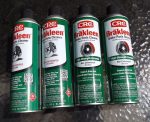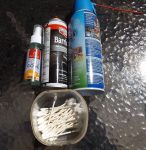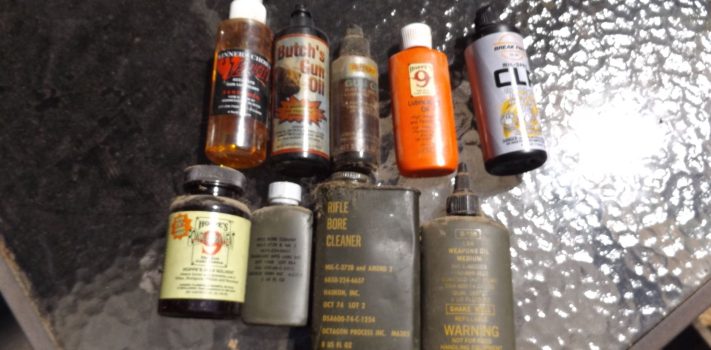We’re going to review any new products today, instead, we’re going to let you in on a few “secrets” to keeping your firearms clean and running. I’m a real stickler when it comes to keeping my meager firearms collection in good shape. I’ve always been this way for as long as I can remember. It got very intense when I worked for the late Col. Rex Applegate, when I maintained his gun collection of more than 850 firearms. It was a monthly chore, believe it or not. The good Colonel didn’t shoot most of the guns in his collection – just the new arrivals, and more often than not, I tested the guns for him, and reported my findings back to him, and he wrote the articles based on my findings. Applegate insisted that I take every single gun in his collection – every single month – and wipe them down with WD-40 – it was what he wanted me to use. But don’t ever use WD-40 for cleaning your guns! It will penetrate into the primers and it will “kill” those loaded rounds. However, Applegate simply wanted all his guns wiped down with WD-40 each month!
On average, it would take me a couple days, each and every month while working for the Colonel, to take each gun, inspect it, and wipe it down with a rag with WD-40 on it. No easy task to be sure. And, I enjoyed being allowed to handle all those guns in his collection, especially some of the prototype firearms as well as the “Guns Of The Famous Shooters” – this involved about 20 handguns that were Applegate’s pride and joy.
When you take a look at the picture of my gun cleaning/maintenance table, it looks like a total mess. However I know where everything is and can easily reach for it when working on firearms. Sadly, even my workbench is cluttered, so whenever I’m working on a gun, it is done on my computer desk. When working on a long gun, I’m forced to do it on the kitchen table though – that’s how cluttered my office is – one day, I’ll organize everything – at least I keep saying that to myself.
Many years ago, when I was doing a lot of gunsmithing, I had a lot of folks bring me their firearms, especially handguns, in a brown paper bag – and inside, the bag was full of a disassembled handgun, that the owner took completely apart and couldn’t put it back together. More often than not, a few parts would be missing, especially small screws – so I kept a good supply of gun screws on-hand at all times. And I’m sure, even today, many gunsmiths can relate to this sort of thing. Many gun owners would bring me a firearm that was “broke” and all it needed was just a thorough cleaning. I maintained the handguns of a firearm’s club for quite some time…and more often than not, their “broken” handguns were just too dirty to function.
It just makes good sense to properly care for your firearms, and that means inspecting, cleaning, and lubing them after you shoot them each time. Its not that big or complicated job if you do maintenance on your firearms right after shooting them…it only takes a few minutes on average to do this, unless you have fired thousands of rounds during your shooting session…most cases, involved giving the barrel a thorough cleaning – that takes times, but easier to do “now” instead of a few weeks later.
I always fall back on Hoppe’s #9 solvent for cleaning barrels – on handguns, shotguns, or rifles – been at this game for more than 50 years now. Honestly, I haven’t found anything that will clean a barrel better and faster than good ol’ #9 does it. Of course, this involves having brass bristle brushes of the right caliber, and they are fairly cheap to keep plenty of extra brushes on-hand at all times. Needless to say, you need a good supply of cleaning patches on-hand as well…don’t use patches that are too big – they’ll get stuck in the barrel. I have had more than a few gun owners bring me a rifle with a patch stuck in the barrel – because it was too big. I’d simply put some gun oil in the barrel, until the patch was soaked, and let it sit for a little while and I was able to easily push the stuck patch out of the barrel with very little effort.
Here is one trick that I learned a long, long time ago – and that is to keep a good supply of Q-Tip cotton swabs on hand, for nearly all my gun cleaning chores. And, there is nothing like these little swabs for reaching into small areas to clean a gun part, and they are especially most appreciated, when it comes to lubing a gun – instead of just squirting lube in an area, I can precisely apply a few drops on a Q-Tip swab and apply the lube exactly where I want it to go. My daughters are always buying me Q-Tips in bulk for Father’s Day, birthdays, and other holidays because I use too many. I would guesstimate that I go through at least 500 of these little swabs each year. Don’t be stingy on this. Buy genuine cotton swabs – the imitation “cotton-like” swabs will come apart on you – not a good thing.
 When it comes to the various gun lubes, I’ve tried most and some are better than others. In the end, I always come back to Break Free CLP for most of my lube jobs. It has Teflon on it, and this fills the microscopic pores in gunmetal, you can’t see them – without a magnifying scope…but they are there just the same. The Tefon fills these little pores in and makes metal-rubbing-on-metal smoother – and on articulating surfaces – slows down wear and tear and you won’t have to replace worn gun parts more than you need to.
When it comes to the various gun lubes, I’ve tried most and some are better than others. In the end, I always come back to Break Free CLP for most of my lube jobs. It has Teflon on it, and this fills the microscopic pores in gunmetal, you can’t see them – without a magnifying scope…but they are there just the same. The Tefon fills these little pores in and makes metal-rubbing-on-metal smoother – and on articulating surfaces – slows down wear and tear and you won’t have to replace worn gun parts more than you need to.
 For a lot of years, I used a commercial spray gun cleaner and it is very expensive – about $8.00+ per can – and you can go through a can in very short order – sometimes cleaning one or two firearms, believe it or not. It is great stuff for blowing out tiny particles of unburnt powder, in hard-to-reach spots. Well, a long time ago, I decided to try some automotve brake cleaner (such as Brakleen) instead of commercial spray-on firearms cleaner. Well, it works just as well, and I can oftentimes find it at the local dollar store for a buck a can, it has saved me a lot of money over the years.
For a lot of years, I used a commercial spray gun cleaner and it is very expensive – about $8.00+ per can – and you can go through a can in very short order – sometimes cleaning one or two firearms, believe it or not. It is great stuff for blowing out tiny particles of unburnt powder, in hard-to-reach spots. Well, a long time ago, I decided to try some automotve brake cleaner (such as Brakleen) instead of commercial spray-on firearms cleaner. Well, it works just as well, and I can oftentimes find it at the local dollar store for a buck a can, it has saved me a lot of money over the years.
I also keep a can of pressurized air – for blowing out the gunk inside of a gun, or for cleaning a scope lens…I don’t like to use even very soft “rags” for wiping off an expensive scope lens – the compressed air works great. Plus I keep a bottle of “no fog” stuff on my gun cleaning table to treat and re-treat scopes – so they don’t fog-up on me – nothing worse than a great shot at a trophy deer, only to bring your gun up to your eye – and the lens is fogged-up. A small bottle will last you for years!
I also keep some small gunsmithing tools and parts on my messy gun cleaning table. Pins, detents, and springs get lost. Screws are always working themselves loose under fire. Make sure you have hollow ground screwdrivers so you don’t bugger up your gun’s screws. Plus, there are various types of clamps and plastic mallets that are used for various types of firearms chores.
Several small diabetic-type syringes are always being used. In some very tight places, that are hard to reach, and you don’t want to over-lube, I put a few drops of lube inside of a syringe and I can put the lube exactly where I want it to go – without applying too much lube in the area. An over-lubed firearm is almost as bad as a firearm that doesn’t have enough lube. Most of the time, a firearm doesn’t take a lot of lube to keep it running smoothly. Articulating surfaces – metal-on-metal is where you really want to apply the lube.
Birchwoo d Casey “Barricade” is what I apply to the outside of my firearms. It helps protect them from the elements – like rain and snow. I apply Barricade to a rag and wipe my guns down with it and let it dry, and it helps prevent rust like you wouldn’t believe. It is inexpensive and goes a long way to help keeping your guns looking like new. When I lived near the Oregon Coast, I still had to use Barricade once a month, or the salt in the air would cause some rusting.
d Casey “Barricade” is what I apply to the outside of my firearms. It helps protect them from the elements – like rain and snow. I apply Barricade to a rag and wipe my guns down with it and let it dry, and it helps prevent rust like you wouldn’t believe. It is inexpensive and goes a long way to help keeping your guns looking like new. When I lived near the Oregon Coast, I still had to use Barricade once a month, or the salt in the air would cause some rusting.
In my Golden Years (and I wish someone would tell me what’s so “Golden” about them) I find I use a pair of magnifying goggles for most of my gun cleaning and gun work. Mine has a small LED light that really is needed to see where you’re working. Mine also has a 4-power and an 8-power magnification – believe me, it’s a small investment to own a pair of these – I got my last pair for around ten bucks.
A lot of “broken” guns can be made to work – almost like magic – if you keep them clean and lubed. It is great insurance to know your gun will go “bang” when you want it to. And, all the stuff I use on a regular basis is really pretty inexpensive to have around.










